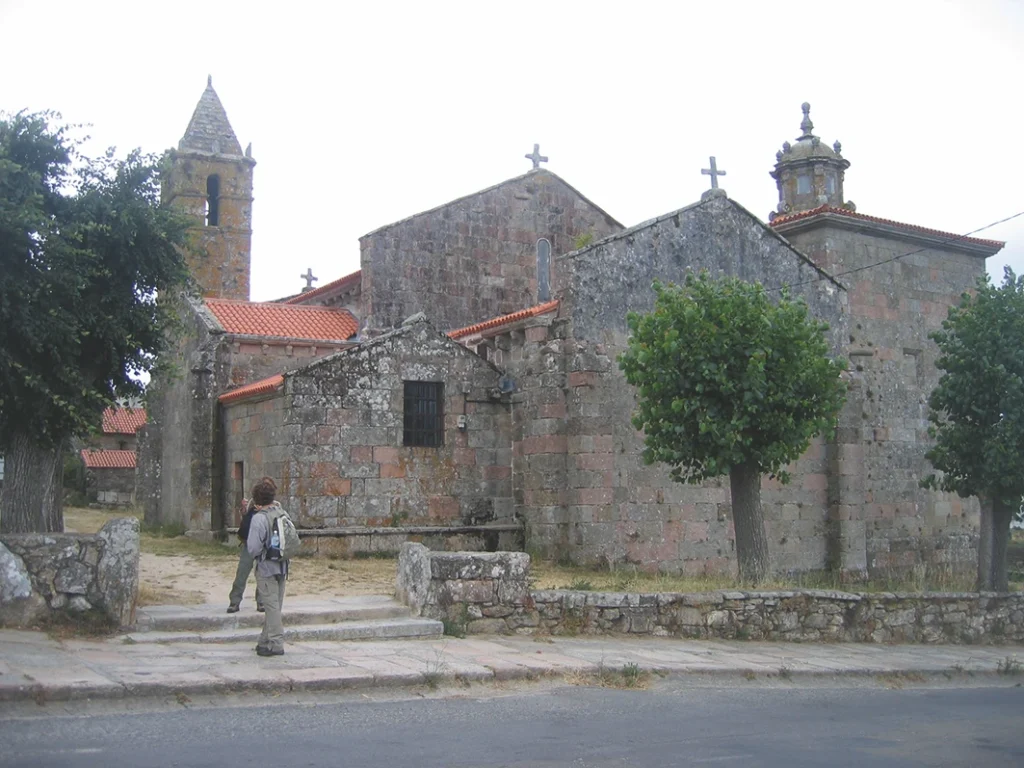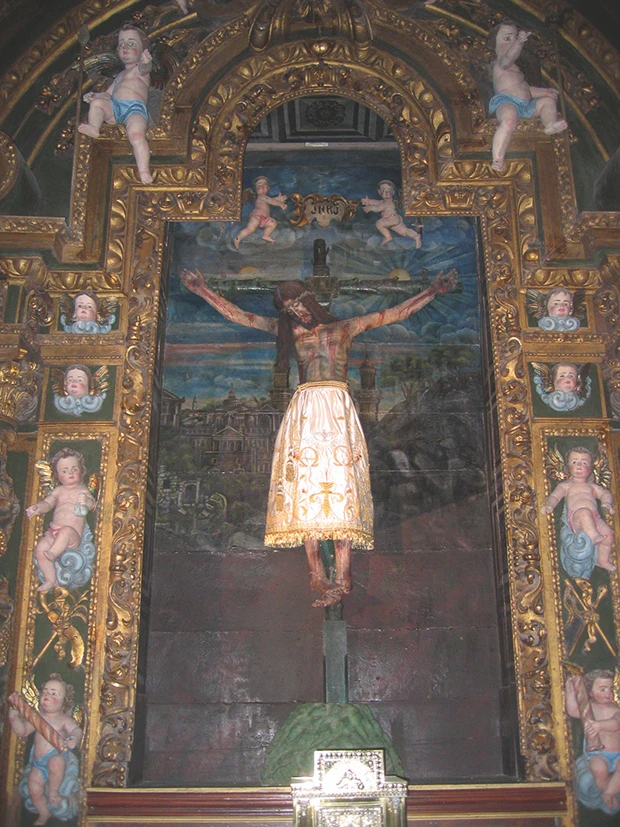
This church is located at the exit from Fisterra to the lighthouse. The reason for placing it outside the town centre and further away from the coast was to protect it from attacks by pirates, which were frequent events on this coast.
The building consists of a hall church, made up of a rectangular main chapel, with a cross-ribbed vault and a nave of the same shape, covered with a timber and tiled roof, divided into four sections by pointed arches, supported by columns embedded into the walls and reinforced on the outside by buttresses The pointed triumphal arch rests on three half-columns on each side.
The main façade is plain, with two buttresses at each end, and Romanesque archivolts that frame the door and act as a decorative feature. Four semicircular arches on columns can be seen opposite, which were built to bear the weight of the portico, which no longer exists. The 16th century bell-tower stands at the southern end, attached to the nave.
Several structures were added to both sides of the primitive Romanesque building, which have disfigured its original shape. The Santo Cristo chapel, which is the largest one, was added to the northern part, and consists of two rectangular and quandrangular elements. It dates back to the late 17th or early 18th century and was built in the Baroque style. The altarpiece, built in the same style, was added in 1721 and was designed and carved by Miguel de Romay, an artist from Santiago. However, the image of Christ is Gothic and was donated by Vasco Pérez Mariño, who was born in Fisterra and a bishop of Ourense. He donated a similar image to the cathedral of Ourense.

The very human way in which the body, clothing and hair are represented, along with the figure’s expression of pain and suffering, give the image a powerful realism that sets out to move the congregation and lead them to repentance.
There are many legends surrounding the Christ. These range from stories in which the figure’s nails and hair grow, to a legend that says that it was made by Nicodemus, the Jew who helped Christ down from the cross. Another legend tells the story of how it arrived at Fisterra by sea. According to the tale, the figure was inside a box thrown into the sea from an English ship that was threatened by a storm, which did not allow the vessel to leave. After the image was hurled overboard, the storm died down and the ship could sail away. The box was then taken by some local sailors to the church.
To the west of the Santo Cristo chapel is the old chapel of the Rosario, now the chapel of Carme, founded by María Blanca in 1534 and built in the Plateresque style. The north wall also contains a beautiful doorway with a mixtilinear arch, which has a coat of arms on each side. The influence of the architect Enrique Egás, who designed the Hospital dos Reis Católicos in Santiago, can be seen here.
The south wall includes the sacristy and the chapel of San Miguel and Las Angustias, from the late 15th c.
The church interior has other works of artistic merit besides the image of Christ: the 16th c. image of Santa María das Areas (Saint Mary of the Sands), the patron saint of the parish, and another 17th c. image of St James the Pilgrim, which highlights the strong tradition of the Way of St James in Fisterra.
The Resurrection of Christ, is re-enacted on Easter Sunday in the field to the south of the church and is attended by thousands of pilgrims. The event is held in front of a grotto at the foot of the hill. In the early morning a group of participants dressed as Roman soldiers guard the cave where the body of Christ is interred. A tremendous sound terrifies the soldiers and they flee, then the door to the cave opens and an angel comes out. The three Marys, in mourning and afflicted, come closer to the tomb and talk to the angel, who tries to convince them that Jesus has risen. Mary Magdalene tells the Virgin Mary, who celebrates the news. Flags are then raised, doves are released, fireworks are set off and music is played in celebration of the event. A group of young girls dressed in white sing the Victimae paschali laudes. The event ends with a traditional dance called the Danza das Areas.